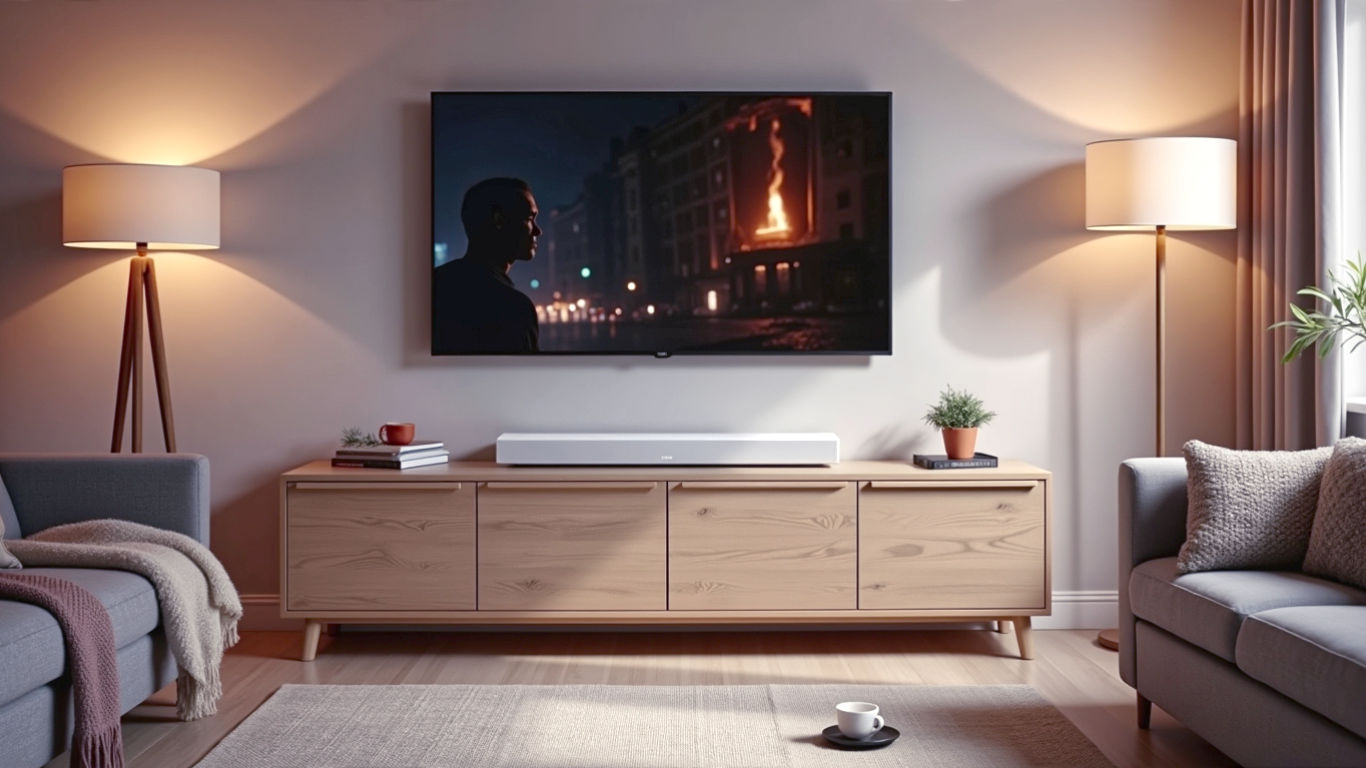The Sonos Ray Soundbar Review: Your Definitive Guide for UK Homes
A comprehensive, hands-on review of the Sonos Ray soundbar. We explore if this compact, budget-friendly soundbar is the best audio upgrade for British TV lovers.

This post may contain affiliate links. If you make a purchase through these links, we may earn a commission at no additional cost to you.
Picture this: it’s a drizzly Saturday night, you’ve got a fresh cuppa, and you’re settling in for the final episode of Line of Duty. The tension is building, the camera zooms in, and AC-12 are about to crack the case… but the dialogue sounds muffled, lost in a sea of tinny background noise coming from your TV’s built-in speakers. It’s a classic British problem, isn’t it? A brilliant telly let down by rubbish sound.
For years, getting great home cinema sound meant a tangle of wires, bulky speakers, and a price tag that could make your eyes water. But what if you could get that room-filling, crystal-clear audio from a single, compact bar that doesn’t cost a fortune or require a degree in engineering to set up?
Enter the Sonos Ray. It’s the smallest and most affordable soundbar from Sonos, a brand known for its high-quality, easy-to-use wireless speakers. But is it any good? Can this little box really transform your movie nights and make your music sound magnificent? Or is it a classic case of getting what you pay for?
In this guide, we’re going to get to the bottom of it. We’ll look at everything from how it feels straight out of the box to how it handles everything from a thumping blockbuster to the subtle strings of the BBC Concert Orchestra. We’ll explore who it’s perfect for, who might need something more, and whether it’s the right bit of kit to upgrade your living room sound. So, grab your remote, and let’s dive in.
What Exactly is the Sonos Ray?
Before we get into the nitty-gritty, let’s clear up what the Sonos Ray actually is. At its heart, it’s a compact soundbar. Think of it as a long, thin speaker designed to sit neatly under your TV. Its job is to replace the weak, down-firing speakers built into most modern flat-screen televisions.
Sonos Ray Soundbar
-
Rich, Balanced Sound from a Compact Bar: Experience surprisingly deep and clear audio thanks to custom-engineered acoustics and proprietary anti-distortion technology that deliver a perfectly balanced soundstage.
-
Never Miss a Word of Dialogue: Fine-tuned by leading sound engineers, this soundbar ensures every line is crisp and clear. For an extra boost, simply activate the Speech Enhancement feature in the Sonos app.
-
Versatile and Smart Placement: Designed to fit your space, this soundbar can be placed on a media stand or mounted to the wall. Its forward-facing acoustic design projects sound directly to you, minimizing interference from other surfaces.
-
Effortless Setup in Minutes: Go from the box to incredible audio in no time. With just two cables and simple, guided instructions from the Sonos app, installation is a breeze.
-
Immersive Stereo Sound: Get pulled into the action with an impressively wide soundscape. Advanced audio processing provides detailed stereo separation that puts you in the center of your favorite movies and shows.
-
Works With Your Existing TV and Remote: Seamlessly integrate the soundbar with your current setup. Connect it to your TV’s optical port and continue using your TV remote for volume control.
-
Stream All Your Favorite Audio: This soundbar is a complete entertainment hub. Beyond your TV, you can easily stream music, podcasts, audiobooks, and radio using the Sonos app, Apple AirPlay 2, and more.
-
Perfect for Late-Night Watching: Enjoy TV without disturbing others. The clever Night Sound feature reduces the intensity of loud effects while keeping dialogue perfectly audible at lower volumes.
-
Expand Your Sound System Wirelessly: Start with the soundbar and build out your dream audio setup over time. Effortlessly add other Sonos speakers to create a true surround sound system or a multi-room listening experience.
-
Instantly Switch to Private Listening: With the TV Audio Swap feature, you can seamlessly move the sound from your soundbar to a pair of Sonos Ace Headphones for a private, undisturbed viewing experience.
But the Ray is more than just a simple speaker. It’s a Sonos speaker. That means it’s part of a bigger family, or what tech folks call an ‘ecosystem’. You can use it on its own, or you can connect it wirelessly to other Sonos speakers around your home to create a multi-room audio system. Fancy listening to Radio 4 in the kitchen while someone else is enjoying a Spotify playlist in the lounge? Sonos makes that happen, all controlled from a simple app on your phone.
The Ray is specifically designed as the entry point into the world of Sonos home cinema. It’s for people who want to dip their toes in the water without spending a grand on the bigger, more powerful Sonos Arc.
Key Features at a Glance
- Compact Design: It’s small enough to fit under most TVs from 32 inches up to 55 inches without looking out of place.
- Simple Setup: It connects to your TV with a single optical cable (included in the box). No faffing about with complicated HDMI ports.
- Crystal-Clear Dialogue: Sonos has put a lot of effort into making voices easy to hear, even during loud action scenes.
- Music Streaming: It’s a brilliant music speaker too, connecting to your Wi-Fi to play tunes from services like Spotify, Apple Music, and BBC Sounds.
- Sonos Ecosystem: It works seamlessly with other Sonos speakers. You can add a wireless subwoofer (the Sonos Sub Mini) or a pair of rear speakers (like the Sonos One SL) later on to create a full surround sound system.
So, in short, the Sonos Ray is a small, smart soundbar that promises big sound for your TV and music, with the cleverness of Sonos baked right in.
Unboxing and First Impressions: What’s in the Box?
There’s something satisfying about opening a new piece of tech, and Sonos has always done a good job with its packaging. It’s all very neat, tidy, and eco-friendly, with no polystyrene in sight.
Slide open the box, and the first thing you’ll see is the Ray itself, snug in a soft fabric sleeve. It feels reassuringly solid and well-made. For a device at the cheaper end of the Sonos range, it certainly doesn’t feel cheap. The grille on the front is made of tough plastic, and the whole thing has a smooth, minimalist look. It comes in two colours: a matte black and a matte white, so you can pick the one that best matches your TV and decor.
Beneath the soundbar, you’ll find a small cardboard wallet containing:
- The Power Cable: A standard UK plug on one end and a figure-of-eight connector on the other.
- The Optical Cable: This is the crucial cable that connects the Ray to your TV. It’s about 1.5 metres long, which should be enough for most setups.
- A Quick Start Guide: Just a few simple pictures showing you where to plug everything in.
And that’s it. No remote control, no clutter. The simplicity is intentional. Sonos wants you to control everything either with your existing TV remote or through the Sonos app on your phone or tablet.
A Closer Look at the Design
The Ray’s design is clever. All the speakers are forward-facing. This might sound obvious, but many soundbars have speakers that fire upwards or sideways to create a wider sound. Because the Ray’s speakers all point directly at you, it means you can tuck it away inside a TV cabinet or on a shelf without muffling the sound. This is a huge plus for anyone with a tight space or a media unit where a bigger soundbar just wouldn’t fit.
On the top, there are some simple touch controls for playing/pausing music, adjusting the volume, and skipping tracks. Handy if you can’t find your phone.
Around the back, it’s just as simple. You’ve got the port for the power cable, the optical port for connecting to your TV, and an Ethernet port if you’d rather connect it directly to your router instead of using Wi-Fi. There are also a couple of threaded holes for wall mounting, though you’ll need to buy the special Sonos bracket separately.
Setting It Up: Is It Really That Easy?
Sonos has built its reputation on being incredibly user-friendly, and the Ray is no exception. Setting it up is about as painless as it gets. Honestly, making a cup of tea is more complicated.
Here’s how it works:
- Place the Soundbar: First, find a home for your Ray. The best spot is directly below your TV, making sure it isn’t blocking the screen or the TV’s remote sensor.
- Plug It In: Connect the power cable to the back of the Ray and plug it into a wall socket. Then, take the optical cable and connect one end to the Ray and the other to the optical output on your TV. This port is usually labelled ‘Digital Audio Out (Optical)’ and has a little protective cap you need to pull off first.
- Download the App: Grab your smartphone or tablet and download the free Sonos S2 app from the Apple App Store or Google Play Store.
- Follow the Instructions: Open the app, and it will guide you through the rest. It will find the Ray automatically, ask for your Wi-Fi password, and get everything connected. This usually takes just a couple of minutes. The app will even show you how to disable your TV’s internal speakers so that all the sound comes through the Ray.
- Pair Your Remote: The final step is teaching the Ray to respond to your TV’s remote control for volume. The app will ask you to point your remote at the soundbar and press the volume up button a few times. And that’s it, job done. You can now control the soundbar’s volume just like you always have, with the remote you already use every day.
The whole process is incredibly smooth. There’s no fiddling with menus or complicated settings. It just works.
A Note on Connections: Optical vs. HDMI
One of the big talking points about the Sonos Ray is that it only has an optical connection. Most other soundbars, including the more expensive Sonos Beam and Arc, use an HDMI ARC (or eARC) connection.
So, what’s the difference, and does it matter?
- Optical: This is an older but still very reliable standard. It carries high-quality digital sound from your TV to the soundbar. It’s simple and works with pretty much any TV made in the last 15 years.
- HDMI ARC: This is a more modern connection. It also carries high-quality sound, but it has a couple of extra tricks up its sleeve. For example, it lets your TV and soundbar ‘talk’ to each other, so turning on your TV can automatically turn on the soundbar.
The main difference for sound quality is that optical connections can’t carry the most advanced surround sound formats, like Dolby Atmos. Dolby Atmos is a fancy technology that makes sound feel like it’s coming from all around you, including above you. It’s what you get in modern cinemas.
Because the Ray uses an optical cable, it does not support Dolby Atmos. For some home cinema fans, this will be a deal-breaker. But let’s be realistic. The Ray is a small, stereo soundbar. It was never designed to create a full-blown, cinema-style surround sound experience on its own. It’s designed to make your TV sound clearer, louder, and more exciting. And for that, the optical connection is perfectly fine. In fact, its simplicity is one of its biggest strengths.
Sound Quality: The Moment of Truth
Right, let’s get to the most important part. How does the Sonos Ray actually sound? We’ll break this down into three key areas: watching TV and films, listening to music, and gaming.
For TV and Films
This is the Ray’s main job, and it does it brilliantly. The difference between the Ray and your standard TV speakers is night and day. It’s like taking cotton wool out of your ears.
The first thing you’ll notice is the clarity of dialogue. Sonos has used some clever acoustic engineering to make sure voices are pushed to the forefront. Whispered conversations in a tense drama are crisp and easy to follow. Shouted commands in an action movie cut through the explosions. This is a huge win for anyone who’s ever had to turn on the subtitles just to understand what people are saying.
The sound is also much wider and more expansive than you’d expect from such a small box. It creates a proper stereo soundstage, so if a car drives from left to right on the screen, you’ll hear the sound move across the room with it. It makes everything feel more immersive and engaging.
What about the bass? The Ray is a small soundbar with no dedicated subwoofer, so it’s never going to shake the room like a proper cinema system. You won’t feel those deep, rumbling explosions in your chest. However, the bass it does produce is surprisingly tight, punchy, and well-controlled. It adds a satisfying weight to action scenes without sounding boomy or muddy. For most people in a typical British living room, the bass is more than enough to make films feel exciting.
Special Sound Features
Inside the Sonos app, there are a couple of extra settings that are really useful for watching TV:
- Speech Enhancement: If you turn this on, it boosts the frequencies of human voices even further. It’s like a superpower for dialogue clarity. It’s fantastic for watching shows where characters mumble a lot, or for anyone who is a bit hard of hearing.
- Night Sound: We’ve all been there. You’re watching a film late at night, and you have to keep grabbing the remote to turn the volume down for loud explosions and then back up for quiet dialogue. Night Sound fixes this. It reduces the volume of loud sounds and boosts the volume of quiet ones, so you can watch comfortably without waking up the rest of the house (or the neighbours).
For Music
The Sonos Ray isn’t just for your TV; it’s a fully-fledged music speaker. And for its size and price, it’s seriously impressive.
Connect it to your favourite streaming service via the Sonos app, and you’ll be rewarded with a rich, detailed, and surprisingly balanced sound. It handles all sorts of music well. Play a rock track like Queen’s Don’t Stop Me Now, and the guitars have bite, the drums have impact, and Freddie Mercury’s vocals soar. Switch to something more delicate, like Adele’s Someone Like You, and the piano sounds warm and natural, with all the emotion in her voice beautifully clear.
The sound is very focused and comes directly from the bar. It doesn’t have the room-filling, wide-open sound of a dedicated pair of stereo speakers, but it’s a massive step up from a typical Bluetooth speaker. It’s perfect for background music while you’re cooking or having friends over, and it’s more than good enough for a proper listening session in the lounge.
For Gaming
Gamers will also find a lot to like about the Sonos Ray. Modern games have incredibly detailed sound design, and the Ray does a great job of bringing those virtual worlds to life.
The stereo separation is a real advantage here. You can hear footsteps creeping up on your left or gunfire whizzing past on your right. It makes it easier to pinpoint where sounds are coming from, which can give you a real edge in competitive games like Call of Duty.
The punchy bass adds excitement to big moments, and the clear dialogue means you won’t miss any important instructions from your teammates or story details from characters in the game. Again, it’s not true surround sound, but it’s a huge and immersive upgrade over TV speakers.
Living with the Ray: The Sonos App and Ecosystem
A big reason to buy a Sonos product isn’t just the hardware; it’s the software and the ecosystem that comes with it. The Sonos S2 app is the command centre for your Ray and any other Sonos speakers you own.
The app is brilliant. It’s clean, simple, and easy to navigate. From here, you can:
- Stream Music: It brings together almost every music streaming service you can think of—Spotify, Apple Music, Amazon Music, Tidal, Deezer, BBC Sounds, TuneIn Radio, and dozens more—all in one place. You can search for a song and the app will look for it across all your services at once.
- Adjust Settings: This is where you can turn on Speech Enhancement and Night Sound. You can also adjust the EQ (bass and treble) to fine-tune the sound to your liking.
- Group Speakers: If you have other Sonos speakers, you can group them together to play the same thing in perfect sync. You could have the sound from the TV playing on the Ray in the living room and a Sonos One in the kitchen, so you don’t miss a moment of the match when you go to grab a snack.
- Trueplay Tuning: This is a really clever feature, but it’s only for people with an iPhone or iPad. Trueplay uses the microphone on your Apple device to listen to how the Ray sounds in your specific room. It then analyses the acoustics—things like the size of the room, the furniture, and where the soundbar is placed—and automatically adjusts the sound to make it as good as it can possibly be. It makes a noticeable difference, tightening up the bass and improving clarity. It’s a shame it’s not available for Android users (due to the huge variation in microphones on Android phones), but if you have an Apple device, it’s well worth doing.
Expanding Your System
The Ray is a great starting point, but the beauty of the Sonos system is that you can build on it over time. If you decide you want more, you can add other components without any wires.
- Want More Bass? You can add the Sonos Sub Mini. This is a compact wireless subwoofer that takes care of all the deep, low-frequency sounds. It connects to the Ray wirelessly and adds a huge amount of depth and impact to movies and music. It’s not cheap, but it makes a massive difference.
- Want Proper Surround Sound? You can add a pair of smaller Sonos speakers, like the Sonos One SL or the new Era 100, to act as rear surround speakers. You place them behind you, and they create a genuine surround sound experience. When a plane flies overhead in a film, you’ll hear it move from the front of the room to the back. It’s a fantastic upgrade that turns your simple soundbar setup into a proper home cinema.
This modular approach is one of Sonos’s biggest selling points. You can start with just the Ray and then build a complete 5.1 surround sound system piece by piece, as and when you can afford it.
Who is the Sonos Ray For? (And Who Should Avoid It?)
The Sonos Ray is a brilliant product, but it’s not for everyone. Let’s break down who it’s perfect for.
The Sonos Ray is an excellent choice for:
However, you might want to consider something else if:
The Verdict: Is the Sonos Ray Worth Your Money?
So, after all that, what’s the final word?
The Sonos Ray is a triumph of simplicity and focus. Sonos set out to make a compact, affordable soundbar that delivers a massive upgrade on standard TV speakers, and they have absolutely nailed it.
It’s not trying to be a full-blown, all-singing, all-dancing home cinema system. It doesn’t have Dolby Atmos, it doesn’t have HDMI switching, and it won’t shake your foundations with earth-shattering bass. But what it does, it does exceptionally well.
It makes dialogue wonderfully clear, adds excitement and weight to films and games, and doubles as a fantastic little music system. The setup is ridiculously easy, the app is a joy to use, and the ability to expand the system later on is a huge bonus.
For the vast majority of people living in typical UK homes, the Sonos Ray is everything they could possibly need from a soundbar. It solves the biggest problem with modern TVs—poor sound—with an elegant, effective, and surprisingly affordable solution. It’s a brilliant bit of kit and a fantastic entry point into the world of Sonos. If you’re looking to take your first step into better audio, you’ll be hard-pressed to find a better place to start.
Further Reading
For more expert opinions and technical deep dives, check out these highly respected resources:
- What Hi-Fi?: https://www.whathifi.com/reviews/sonos-ray
- TechRadar: https://www.techradar.com/reviews/sonos-ray
- The Guardian (Tech): https://www.theguardian.com/technology/sonos
- Trusted Reviews: https://www.trustedreviews.com/reviews/sonos-ray







